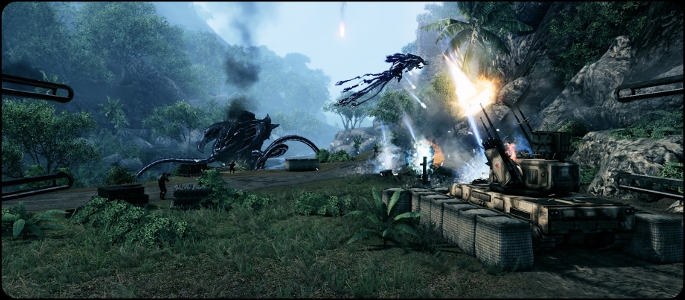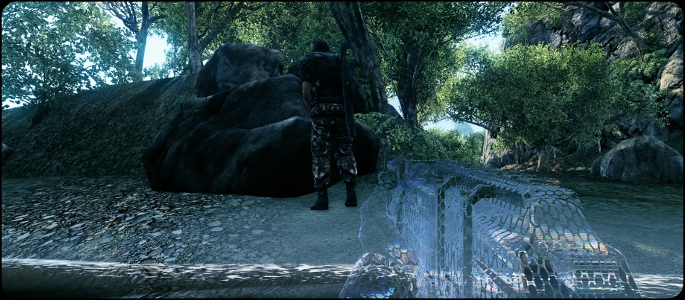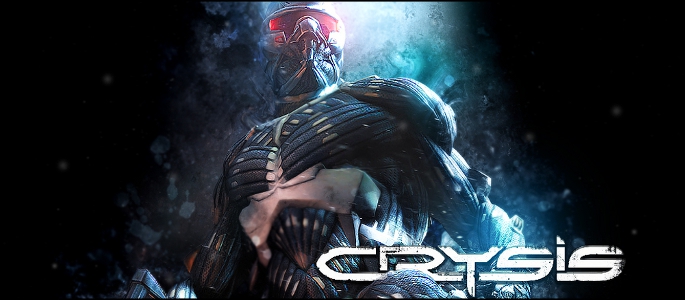In 2007, Crysis released for PC and became an instant legend for pushing the graphical bar so far that the majority of desktops on the market were simply unable to run it. Despite the PS3 being one year older than Crysis, the system is now running the game without hindrance, something many thought was impossible. However, time has passed, and not ever game can retain its sense of entertainment after four years have lapsed. Has this technical deviant made an enjoyable transition to console architecture, or should it have just stayed on its platform of origin?
Of course, the immediate question that comes to mind is regarding how well the PS3 runs Crysis. Crysis isn’t just a straight port to the PS3, and actually runs on the new Cryengine 3 which was developed for use with Crysis 2. As a result, we see a new coat of polish on the game, in particular with an improvement to the lighting effects. Crysis by all means looks beautiful as a result on the PS3, although we can still see some pop-in that may not result on PCs with higher RAM. For a four year old game it manages to hold its own with the current generation, and sports some of the best visuals to date from a downloadable shooter on PSN. To top it off, this new version has also integrated stereoscopic 3D support for those of you lucky enough to own a compatible TV.
While Crysis is legendary for its power demands and graphical quality, there’s so much more to the actual game that makes it great. Players take control of a US Special Forces Operative, codenamed Nomad, who is sent in to Lingshan to rescue hostages taken captive by the North Korean Military. The hostages sent out a distress call, in which they say they’ve discovered something that could change the world, and clearly the Koreans want it. The US isn’t holding back either, and have equipped Nomad with a special nanosuit, which helps to make Crysis a distinctly fun and tactical game to play through.
The nanosuit packs a punch, and grants Nomand a number of special abilities which can effectively make him powerful enough to fight an entire army. Primarily, it comes with stealth technology that renders Nomad virtually invisible for a few moments, as well as armor technology that increases his defense. The suit also enables a super fast sprint, super strong melee attacks, super jumps, and powerful throwing moves. Each of these uses energy, which slowly regenerates while not in use. As a result these abilities are limited and must be used with care. Nomad’s binoculars help accordingly, and allow you to assess a situation prior to engagement and mark important enemies and vehicles on your tactical mini-map. Vehicles like jeeps, tanks, and boats help break up the pacing and provide more options, making these preliminary surveys that much more important.

While much of Crysis is semi-linear with a clearly marked objective always on the map, how to clear objectives is left up to the player, with the aforementioned nanosuit abilities providing a variety of possible solutions to each situation. This core idea is what makes Crysis so very fun. Stealthy players will find a huge advantage in sneaking past a group of guards, while those who prefer Rambo-like tactics can feel like a total power house by wreaking havoc with guns blazing. This isn’t to say the nanosuit is invulnerable though, and keeping a close eye on your surroundings and suit’s energy levels are key to survival. However, it does mean that there’s always several ways to handle most encounters, and smart players will quickly learn to strike a balance between stealth and strength. To help increase these options even further, each weapon in the game comes with a number of customizable options, like selecting various scopes, flashlights, laser pointers, silencers, and even ammo types, letting you select the proper gear for clearing out military bases.
While the gunplay and tactical options stand up well in Crysis when placed next to the best of current generation shooters, the game does unfortunately have a few faults, which carried over from the original release. The most noticeable of these is the often erratic enemy AI, which tends to pop up most while facing the Korean military and attempting stealth. The enemy soldiers have odd habits, which involve losing track of the player easily sometimes, while at other times noticing the player from extreme distances while cloaked, when it should be impossible to see them. Usually this can be easily resolved with a bullet to their head, but there were number of instances where I was cloaked and hidden in the dark, only to find myself being shot at while trying to find a spot to recharge. This can be frustrating at first, but oddly enough they usually shoot, and immediately lose track of the player again, as if it never happened.

Besides that, Crysis also has a few odd checkpoint locations, and no ability to save your game at any other specific time. Normally this wouldn’t be an issue since checkpoints are fairly frequent, but they activate when crossing an invisible line and save the exact current situation, instead of a set starting point. Most of the time this works fine, but when you cross a check point with no ammo and three suddenly alert enemies in front of you it can lead to some very aggravating deaths. The result is restarting and dying over and over until you figure out a way to escape, or at the worst restarting the entire level. This got me several times, with the worst scenarios landing me directly in the line of fire of a tank, and the other check point activating in mid air as I hopped a fence, landing me in the middle of a group of enemies I didn’t know were there.
It’s questionable that Crysis‘ multiplayer portion was left out, as well as the PC expansion, Crysis: Warhead. Despite these omissions, Crysis brings a great single player campaign to the table, which has the ability to keep the average gamer occupied for about 8-10 hours, with some explosive moments to keep it flowing forward. The story line and voice acting aren’t going to knock your shoes off, but provide enough powerful moments to keep you shooting, which is where the real fun is here. There’s certainly never been a cheaper way to enjoy Crysis than right now on PS3, so if you’ve always wanted to see what everyone was talking about in 2007 without the expensive price tag, this is the way to do it.
PlayStation LifeStyle’s Final Score
+ Nanosuit allows for rewarding flexibility. + Dynamic combat, custom weapon parts, and plenty of tactical choices. – Omission of multiplayer portions. |
 |








